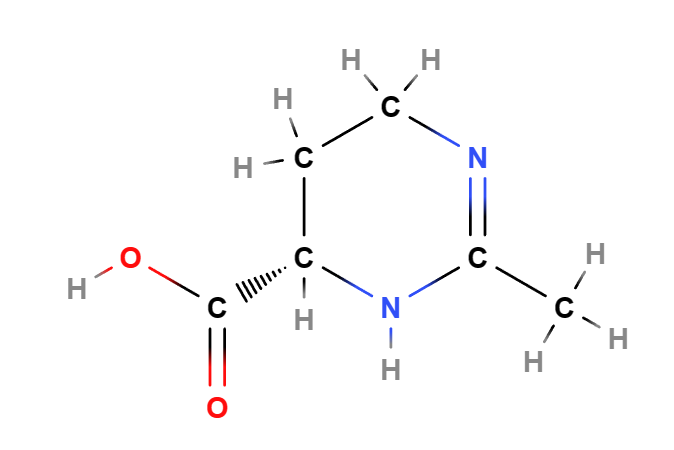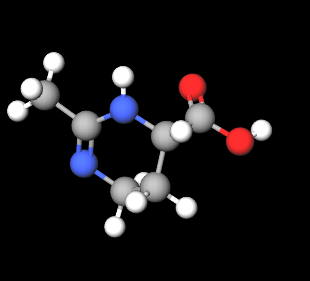Ectoine is a naturally derived chemical compound, specifically a heterocyclic carboxamidine formed by the formal condensation of (2S)-2,4-diaminobutanoic acid with acetic acid. It occurs naturally in the bacterium Halomonas elongata, the mesophilic bacterium Methylophaga thalassica, the antifungal bacterium Streptomyces nodosus, and other organisms.
Industrial Production Process
- Cultivation of extremophilic bacteria. Halomonas elongata bacteria, which naturally produce ectoine, are cultivated under controlled saline conditions to stimulate its synthesis.
- Fermentation. The bacteria are placed in fermenters, where they grow and synthesize ectoine. Salt concentration, temperature, and other parameters are adjusted to optimize production.
- Cell lysis. After fermentation, the bacterial cells are broken down to release ectoine into the surrounding medium.
- Initial purification. The fermentation mixture is filtered to remove cell debris and other solid impurities.
- Extraction and concentration. Ectoine is extracted via chromatography or other separation techniques, and the solution is concentrated to increase purity.
- Crystallization. The concentrated solution is cooled to crystallize ectoine. The formed crystals are collected for further purification.
- Final purification. The crystals are further purified through washing and recrystallization to ensure a high degree of purity.
- Quality control. The final product undergoes rigorous testing to verify purity, identity, and compliance with standards.
What it is used for and where
Ectoine is an active ingredient found in cosmetic formulations due to its ability to retain moisture and protect the skin from external stressors. It helps prevent dehydration and maintain the integrity of the skin barrier, reducing signs of aging and providing relief to sensitive skin. It is often used in moisturizing creams, serums, and after-sun products for its soothing and regenerative effects.
Cosmetics - INCI Functions
- Skin conditioning agent. It is the mainstay of topical skin treatment as it has the function of restoring, increasing or improving skin tolerance to external factors, including melanocyte tolerance. The most important function of the conditioning agent is to prevent skin dehydration, but the subject is rather complex and involves emollients and humectants that can be added in the formulation.
Cosmetic Applications
Moisturizing Properties. Ectoin helps keep the skin hydrated by attracting and retaining moisture, improving elasticity and reducing dryness.
Protective Effect. Creates a barrier on the skin that shields it from external agents, such as pollutants and UV radiation, helping prevent environmental damage.
Inflammation Reduction. It has anti-inflammatory properties that reduce skin irritation and redness, making it ideal for sensitive or damaged skin.
Regenerative Effects. It supports skin regeneration, speeding up the healing process of wounds and improving the appearance of scars and blemishes.
Versatile Applications. It can be incorporated into various cosmetic products, such as creams, lotions, and serums, for its moisturizing and protective benefits.
Medicine
Dermatology. Ectoin has demonstrated anti-aging activity that prevents DNA hypermethylation and subsequently activates genes that can suppress cancer (1).
Saline Solution. Ectoin is used in saline solutions to reduce nasal mucosal inflammation and relieve allergy and cold symptoms (2).
Pharmaceutical Industry. Used as a protective ingredient in pharmaceutical formulations to improve the stability and effectiveness of medications.
Ophthalmic Products. Used in eye drops and eye care products to relieve dry eyes and prevent inflammation.
Molecular Formula C6H10N2O2
Molecular Weight 142.16 g/mol
CAS 96702-03-3
UNII 7GXZ3858RY
EC Number 431-910-1
Synonyms:
Ectoine
L-Ectoine
References_____________________________________________________________________
(1) Qaria MA, Xu C, Hu R, Alsubki RA, Ali MY, Sivasamy S, Attia KA, Zhu D. Ectoine Globally Hypomethylates DNA in Skin Cells and Suppresses Cancer Proliferation. Mar Drugs. 2023 Nov 29;21(12):621. doi: 10.3390/md21120621. PMID: 38132942; PMCID: PMC10744768.
Abstract. Epigenetic modifications, mainly aberrant DNA methylation, have been shown to silence the expression of genes involved in epigenetic diseases, including cancer suppression genes. Almost all conventional cancer therapeutic agents, such as the DNA hypomethylation drug 5-aza-2-deoxycytidine, have insurmountable side effects. To investigate the role of the well-known DNA protectant (ectoine) in skin cell DNA methylation and cancer cell proliferation, comprehensive methylome sequence analysis, 5-methyl cytosine (5mC) analysis, proliferation and tumorigenicity assays, and DNA epigenetic modifications-related gene analysis were performed. The results showed that extended ectoine treatment globally hypomethylated DNA in skin cells, especially in the CpG island (CGIs) element, and 5mC percentage was significantly reduced. Moreover, ectoine mildly inhibited skin cell proliferation and did not induce tumorigenicity in HaCaT cells injected into athymic nude mice. HaCaT cells treated with ectoine for 24 weeks modulated the mRNA expression levels of Dnmt1, Dnmt3a, Dnmt3b, Dnmt3l, Hdac1, Hdac2, Kdm3a, Mettl3, Mettl14, Snrpn, and Mest. Overall, ectoine mildly demethylates DNA in skin cells, modulates the expression of epigenetic modification-related genes, and reduces cell proliferation. This evidence suggests that ectoine is a potential anti-aging agent that prevents DNA hypermethylation and subsequently activates cancer-suppressing genes.
(2) Sonnemann U, Scherner O, Werkhäuser N. Treatment of rhinitis sicca anterior with ectoine containing nasal spray. J Allergy (Cairo). 2014;2014:273219. doi: 10.1155/2014/273219.
Abstract. Objectives. The safety and efficacy of ectoine nasal spray and ectoine nasal spray with dexpanthenol in the treatment of rhinitis sicca were evaluated in two studies. Design and Methods. Two noninterventional observational studies were performed to evaluate the efficacy and safety of a nasal spray containing ectoine (study 1) and ectoine/dexpanthenol (study 2) over a period of two weeks including comparable numbers of patients suffering from rhinitis sicca anterior. Patients and physicians were asked to rate the efficacy in reducing symptoms and the tolerability over the treatment phase. Results. The treatment in both studies resulted in a clinical and statistical significant reduction of the main diagnosis parameters, nasal airway obstruction, and crust formation. There was also a significant reduction in the secondary diagnosis parameters in both studies. Importantly, the tolerability was very good. During the whole observational study, neither patients nor doctors stopped the medication due to unwanted effects. Conclusion. Rhinitis sicca could be successfully treated with a nasal spray containing ectoine and a nasal spray combining ectoine with dexpanthenol. The combination of both substances led to slight advantages.
![]() Ectoine
Ectoine 



